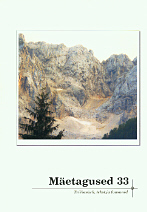Eesti kunstnikud ajakirjandusgraafikas 1930. aastail
Estonian Artists of Graphic Arts in Journalism in the 1930s
Author(s): Merle TalvikSubject(s): Fine Arts / Performing Arts
Published by: Eesti Kirjandusmuuseum
Keywords: graphic art in journals; art déco; Estonian art; calligraphy; Higher Art School Pallas; State School of Applied Arts; design graphics
Summary/Abstract: The period of 1930-1940 marked the first surge of interest in graphic arts in Estonian journalism. The importance of artists who had received education in homeland increased and the following schools of specific creative image emerged - the school of Tallinn artists, who had mostly been educated at the State School of Applied Art, determined the face of magazines published in Tallinn (e.g. Muusikaleht, Huvitav Žurnaal, Kirilind, Lood Elust, Maaomavalitsus, Teater, Välis-Eesti Almanak, Sõdur, Käsitööleht, Laste Rõõm, Kaitse Kodu!) and the Tartu school of graphic artists, who had been educated at the Higher Art School Pallas, designed the face of magazines and journals published in Tartu (e.g. Olion, Tänapäev, Varamu, Teater Vanemuine, Kevadik). Art déco style became the common feature of these two schools of art. The curricula of the School of Applied Arts followed the example of curricula at the Stieglitz School of Applied Arts in St. Petersburg, which was oriented to systematic teaching in calligraphy and decorative art. The school had established good contacts with art institutions in Germany that were considered the most prestigious ones in Europe at the time. National ornamentation was abundantly used. In the 1930s, the Tallinn School laid a solid foundation for the development of Estonian graphic design by ensuring the continuity of education in this field. The work of the Tallinn school is characterised by art decoésque stilisation, moderate use of the element of nationalism and strong composition, also clear and legible script. The indisputable authority for this generation on both decorative art and calligraphy was Günther Reindorff (1889-1975), who devised the systematic methods in teaching calligraphy in Estonia. The most important representatives of the Tallinn school in the graphic art in journalism were Johann Naha (1902-1982), Paul Luhtein (born in 1909), Hugo Lepik (1905-2001), Werner Birkenfeldt (1903-1942), Eduard Salu (1906-1967), Ferdinand Liiv (1912-1948), Voldemar Tomassov (1906-1961), Axel Rossmann (1899-1974), Richard Pallas (1908-1951), Romulus Tiitus (1906-1982), Ferdinand Kask (1900-1941), Roman Haavamägi (1891-1964), Paul Liivak (1900-1942), Eugen Vaino (1909-1969) and Adamson-Eric (1902-1968).
Journal: Mäetagused. Hüperajakiri
- Issue Year: 2006
- Issue No: 33
- Page Range: 7-40
- Page Count: 34
- Language: Estonian

